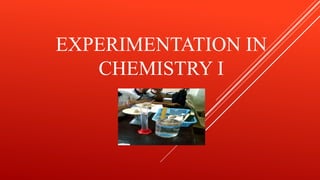
Experiment in Chemistry 1
- 2. . Experiment No. 1 Experimentation in Chemistry Theory: Chemist (scientists) make a great deal of experimentation as they apply scientific methods of study. The greatest part in a chemist’s activities is spent in experimentation.
- 3. . You too, as beginning chemists, will have to perform experiments that will enable to solve problems you will encounter in the study of chemistry.
- 4. . When gold and silver alloys are molded or shaped into fine jewelries, no new substances is formed. Only a change in physical form (shape) occurs. Hence, this is called a physical change. For example, when solid water (ice) is heated, it first changes to liquid water and finally to steam.
- 5. . There is no change in the composition of the substance, only in the form in which it exists. Consider the change that takes place when salt dissolves in water. Even though the form of salt changes, the composition does not. It is still sodium chloride (NaCl), but now it is dissolved in water.
- 6. . . A chemical change occurs when new substances is formed. The new substance have properties entirely different from those of the original substances. The original substances are called reactants; the new substances formed are called products.
- 7. .Burning candle is an example of chemical change. When a candle burns it produces heat, flame, and soot. Soon the candle disappears, actually two new substances are formed- carbon dioxide and water vapor. You do not see these products because they are lost to the atmosphere.
- 8. In this activity, you will perform some common laboratory techniques in order to identify the characteristics of physical and chemical changes.
- 9. . .OBJECTIVES: a) To know what are needed for burning to take place. b) To know the products of burning. c) To know the gases and the particles that makes up the air.
- 10. . d) To differentiate physical changes from chemical changes e) To classify some changes as physical and chemical
- 13. MATCHSTICKS .
- 14. CARDBOARD .
- 15. . .
- 16. MOTHBALLS
- 17. VINEGAR .
- 18. . BAKING SODA
- 19. BEAKER .
- 20. DRINKING GLASS .
- 21. CRUMPLED PIECE OF PAPER
- 23. EGG .
- 24. SUGAR .
- 26. IRON FILINGS .
- 27. MAGNET .
- 28. . .
- 29. TEST TUBES & TEST TUBE RACK .
- 31. . .PROCEDURES
- 32. . .1. Quickly blow out the candle flame and quickly relighted the candle at the column of smoke ½ cm from the wick. Record your observation. See Figure 1
- 33. FIGURE 1 .
- 34. . 2. Move a horizontally held piece of cardboard quickly down over the flame of a burning candle. Take note, do not burn the cardboard. Record your observation.
- 35. ‘. 3) a) Invert a beaker over a lighted candle. Take note the time the flask completely covered the candle and the time the candle flame is put off. See Figure 2. Record your observation.
- 36. FIGURE 2 .
- 37. . .b) Relight the candle, invert a smaller beaker over the lighted candle. Take note again the candle flame is extinguished.
- 38. . .4) Fill a beaker with cold water. Add one (1) teaspoon of vinegar, then add one teaspoonful of baking soda. Stir well. Quickly drop the mothballs. See Figure 3. Record your observation after a few minutes.
- 39. FIGURE 3 .
- 40. . .5) Place a sheet of crumpled paper inside an empty glass. Let it rest at the bottom. Put the glass mouth down into the beaker full of water.
- 41. . Push the glass slowly into the water until it reaches the bottom of the beaker. Get the paper from the glass. Is the paper wet or dry?
- 42. . 6) Use a hard-boiled egg with its shell removed. Light a piece of paper and drop it into an Erlenmeyer flask or a wide-necked bottle. Place the egg (sharp end down) on the flask and observe what happened. See Figure 4.
- 43. FIGURE 4 .
- 44. . . 7) Ignite 2 ml of alcohol in an evaporating dish Record your observations: __________________________________ __________________________________ __________________________________
- 45. . .8) Allow 2 ml of alcohol to stand in a watch glass for five minutes. See Figure 5. Observations: _____________________________________ _____________________________________ _____________________________________
- 46. FIGURE 5 .
- 47. . 9) Place 5 grams of iron fillings in a watch glass and magnetize. Record your observations: ______________________________________ ______________________________________ ______________________________________
- 48. . 10) Place a small pieces of ice cubes in a beaker for a few minutes. See Figure 6. Record your observations: ___________________________________ ___________________________________ ___________________________________ Record
- 49. FIGURE 6 .
- 50. . ’11) Burn a small piece of magnesium ribbon. See Figure 7. Record your observations: ____________________________________ ____________________________________ ____________________________________
- 51. FIGURE 7 .
- 52. . 12) Dissolve a pinch of sodium chloride crystals in 10 ml of water. See Figure 8. Record your observations: ___________________________________ ___________________________________ ___________________________________
- 53. FIGURE 8 .
- 54. . 13) Dissolve one spoonful of sugar in 4 spoonful of vinegar. Record your observations: ___________________________________ ___________________________________ ___________________________________
- 55. . 14) Dissolve one spoonful of baking soda in 4 spoonful of vinegar. Record your observations: _________________________________ _________________________________ _________________________________
- 56. . For Discussion: Answers to be submitted next meeting: 1. What are the requirements for burning to take place? 2. What are the product of burning? 3. What are the gases and particles that makes up the air?
- 57. . 4) In procedure 5, is the paper wet or dry? What is the reason behind? 5) Which of the substances have undergone chemical changes? 6) Which of the substances have undergone physical change? 7) Differentiate chemical change from a physical change.
- 58. . CONCLUSION
